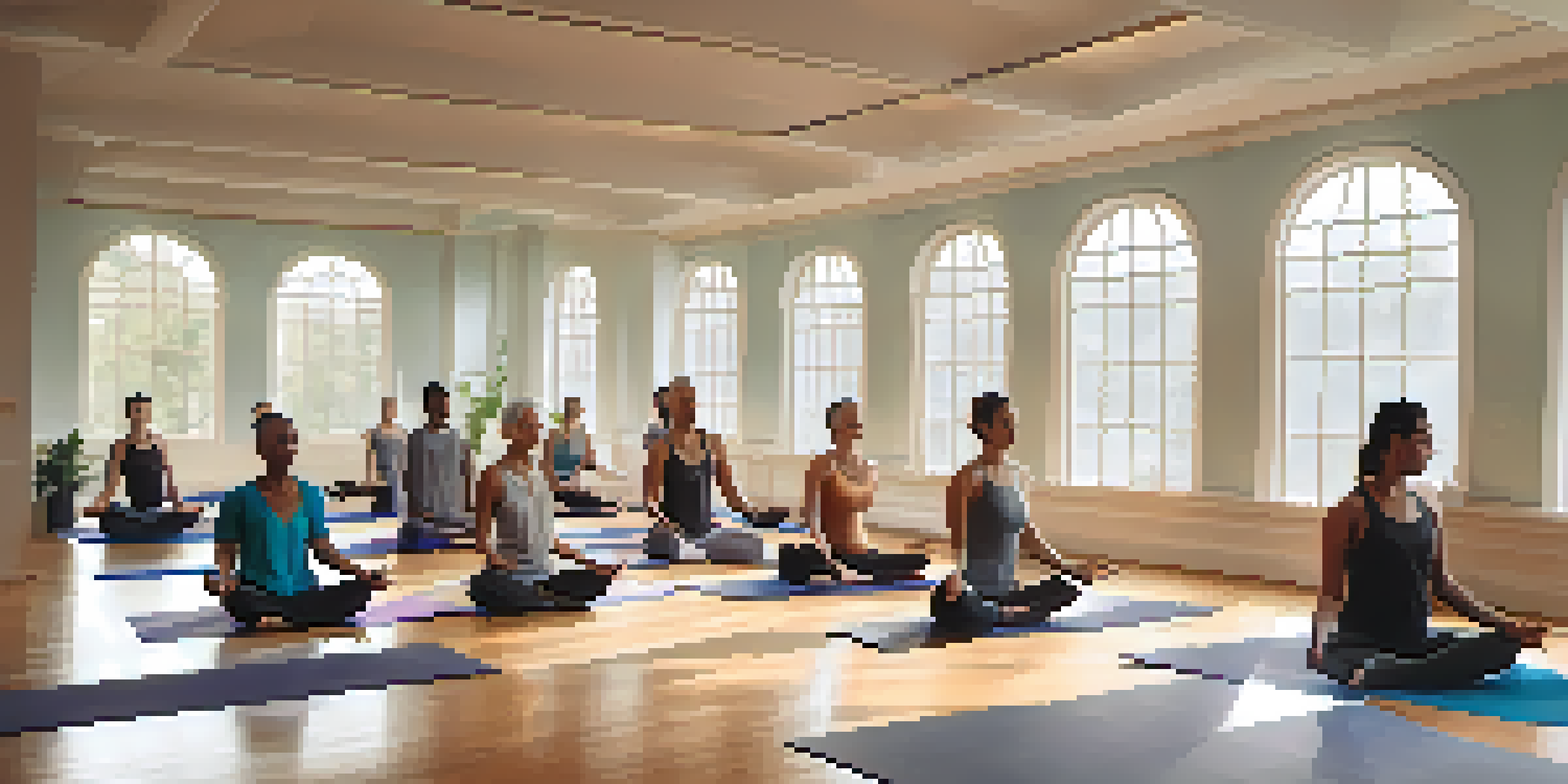Bikram Yoga: The Heated Journey to Detoxification

What is Bikram Yoga and Its Origins?
Bikram Yoga is a unique style of yoga created by Bikram Choudhury in the 1970s. It consists of a series of 26 postures performed in a heated room, typically set at 105°F (40°C) with high humidity. This specific environment was designed to mirror the heat and humidity of India, where traditional yoga originated, enhancing flexibility and promoting detoxification.
Yoga is the journey of the self, through the self, to the self.
The practice itself is often described as a moving meditation, encouraging practitioners to focus on their breath and body amid the heat. Each class lasts about 90 minutes, guided by a certified instructor who ensures participants maintain proper alignment and safety. This structure helps create consistency and can be beneficial for both beginners and seasoned yogis alike.
Related Resource
As people engage in this heated practice, they often find a deeper connection to their body and mind, paving the way for personal growth and transformation. The blend of heat and movement works to challenge students, pushing them to explore their limits while fostering a sense of community among practitioners.
Benefits of Practicing Bikram Yoga
One of the primary benefits of Bikram Yoga is its ability to promote detoxification through sweat. The high temperatures encourage the body to release toxins, which can lead to clearer skin and improved overall health. As you move through the postures, the heat helps to flush out impurities, making you feel refreshed and revitalized.

In addition to detoxification, Bikram Yoga enhances flexibility and strength. The series of postures targets different muscle groups, helping to alleviate tension and improve range of motion. The consistent practice can lead to increased muscle tone and a stronger core, making it a fantastic workout for those seeking physical fitness.
Bikram Yoga: A Heated Practice
Bikram Yoga consists of 26 postures performed in a heated room, promoting detoxification and flexibility.
Moreover, many practitioners report mental benefits such as reduced stress and anxiety. The combination of breath control and focused movement helps to calm the mind, creating a sense of peace that lasts long after class ends. This holistic approach to well-being is one of the reasons Bikram Yoga has gained popularity worldwide.
Preparing for Your First Bikram Yoga Class
Before you step into your first Bikram Yoga class, it's crucial to prepare both mentally and physically. Hydrating well in the days leading up to class can help your body cope with the heat. Aim to drink plenty of water, and avoid heavy meals just before class to prevent discomfort during practice.
The mind is everything. What you think you become.
It's also a good idea to wear lightweight, breathable clothing that allows for free movement and sweat absorption. Many practitioners opt for form-fitting attire, which helps instructors monitor alignment and posture. Don't forget to bring a towel and a yoga mat, as most studios require these essentials for hygiene and comfort.
Related Resource
Finally, approach your first class with an open mind and a willingness to learn. It's normal to feel challenged in the heat, but remember that everyone's journey is unique. Listen to your body, take breaks when needed, and most importantly, enjoy the experience of trying something new.
The Role of Breath in Bikram Yoga
Breath is a fundamental aspect of Bikram Yoga, guiding movements and enhancing concentration. The technique of breathing deeply through the nose, known as Ujjayi breath, helps to increase oxygen intake and promote relaxation. This controlled breathing pattern is essential, especially in a heated environment, as it aids in maintaining focus and stability throughout each posture.
In addition to supporting physical endurance, mindful breathing encourages a sense of calm and mental clarity. As you inhale and exhale deeply, you're not just working on your poses; you're also cultivating a deeper connection to your body and mind. This awareness can transform your practice, allowing for a more enriching experience.
Holistic Benefits of Bikram Yoga
Practicing Bikram Yoga not only enhances physical strength and flexibility but also reduces stress and promotes mental clarity.
Practitioners often find that breathwork becomes an anchor during challenging moments. When faced with difficult postures or the intensity of heat, focusing on your breath can help you stay grounded. This skill not only benefits your yoga practice but also extends to daily life, providing tools for stress management and emotional regulation.
Common Misconceptions About Bikram Yoga
One common misconception about Bikram Yoga is that it's only suitable for advanced practitioners. In reality, this style of yoga welcomes all levels, from beginners to seasoned yogis. The structured class format allows everyone to work at their own pace, making modifications as needed while still reaping the benefits of the practice.
Another myth is that Bikram Yoga is solely about sweating and losing weight. While the heat does promote sweating and can assist with weight management, the focus of Bikram Yoga lies in building strength, flexibility, and mental resilience. It's essential to remember that yoga is a holistic practice that nurtures both the body and mind.
Related Resource
Lastly, many people believe that Bikram Yoga is dangerous due to the heat. While it's true that the high temperatures can be intense, practitioners are encouraged to listen to their bodies and take breaks when necessary. With proper hydration and awareness, the risk of injury is significantly reduced, allowing for a safe and effective practice.
Post-Class Recovery: Hydration and Nutrition
After a Bikram Yoga class, it's crucial to focus on recovery to replenish lost fluids and nutrients. Hydration is key; drinking water immediately after class helps restore your body's balance. Some practitioners opt for electrolyte drinks to replace lost minerals, ensuring optimal recovery and preventing dehydration.
In addition to hydration, nourishing your body with healthy foods can significantly enhance recovery. A post-class meal rich in proteins, healthy fats, and carbohydrates can help repair muscles and refuel energy levels. Consider options like a smoothie with protein powder, nuts, or a hearty salad with lean protein to support your body's needs.
Community and Connection
Bikram Yoga fosters a supportive community, encouraging friendships and shared experiences among practitioners.
Lastly, listening to your body is vital during this recovery phase. You may feel fatigued or sore after an intense class, which is completely normal. Give yourself permission to rest, stretch gently, and engage in restorative practices to allow your body to heal and adapt.
The Community Aspect of Bikram Yoga
Bikram Yoga often fosters a strong sense of community among practitioners, creating a supportive environment for personal growth. Many studios organize social events, workshops, and challenges, encouraging participants to connect and bond outside the classroom. This camaraderie can enhance motivation and accountability, helping everyone stay committed to their practice.
Additionally, practicing in a group setting can amplify the energy in the room, making classes feel more dynamic and invigorating. Sharing the experience with others can boost your morale, pushing you to challenge yourself while also celebrating each other's successes. This shared journey can transform individual practice into a collective experience.

Ultimately, the community aspect of Bikram Yoga can be one of its most rewarding features. Many practitioners find lifelong friendships and support systems, enriching their yoga journey beyond the physical postures. Embracing this sense of belonging can enhance your overall experience, making each class a step towards both personal and communal transformation.